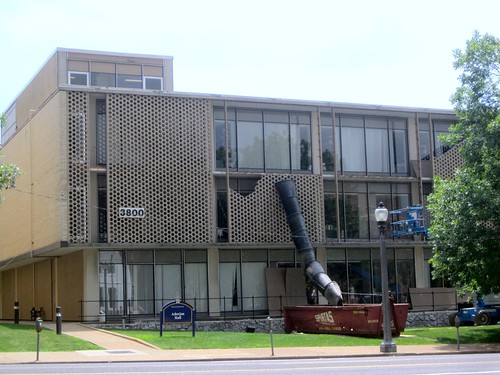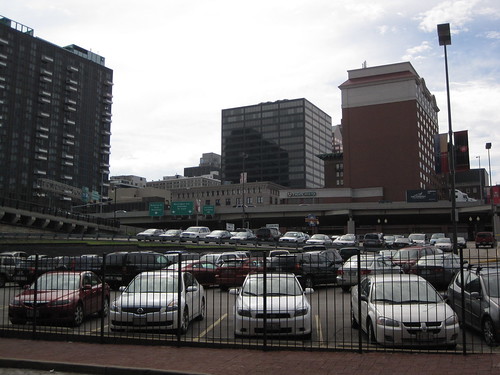
Author: Michael R. Allen
by Michael R. Allen
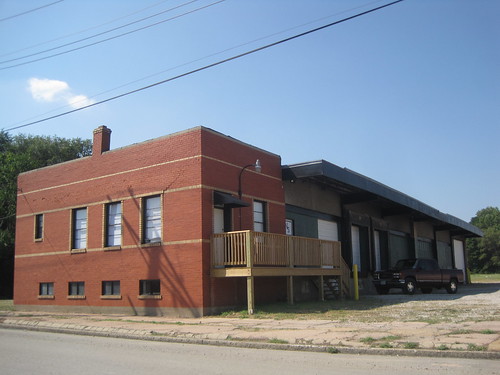
In the United States, historic preservation almost always is a function of property ownership. The agency of an owner to make choices can lead to some puzzling losses and some unlikely saves. Readers know that the historic preservation agenda of Northside Regeneration has been of great interest to this writer for years. Thus I was pleasantly surprised that the company chose to rehabilitate a pretty unremarkable — but solid and attractive — former truck transfer depot at Howard and in Old North as its field office.

The office is within the “Area A” of the larger redevelopment plan — an area that has a separate redevelopment ordinance still in effect unlike the vacated master ordinance. This area currently is mounded with a variegated array of crushed materials flowing to and from new river bridge. Here Northside Regeneration proposes a materials recycling center, and just behind the new field office is the landing of the old Illinois Terminal interurban trestle that Great Rivers Greenway will repurpose as a trail.
Will the little transfer depot — one of many built north of downtown in the 1930s in place of rows of tenement houses — survive the changes coming in this area? That is not certain, but for now Northside Regeneration has an unlikely first completed rehabilitation project.
by Michael R. Allen
After over a year of research, filming, interviews and editing, Bill Streeter is set to show the world his first feature film, Brick By Chance And Fortune. Bill’s film is a humane endeavor, starting with a very moving story of personal love for brick architecture from artist Sheila Harris and moving through topics as diverse as the history of St. Louis clay mining, the impact of hydraulic press brick production on vernacular architecture, historic preservation and — as sung out powerfully in the soundtrack by Pokey LaFarge — brick thieves.
Above all else, this film is a look at the human dimension — why we built such great architecture in fired clay, and why we so fiercely defend brick buildings today. Bill uses interviews to form a narrative arc that joins different voices that bring together the variable parts of our city’s indelible link to a seeming common building material.
Read more about the film at its website. The “brick film” debuts on Sunday, August 14 at 4:30 p.m. as part of the St. Louis Filmmakers Showcase at the Tivoli Theatre. Order tickets online here.
by Michael R. Allen
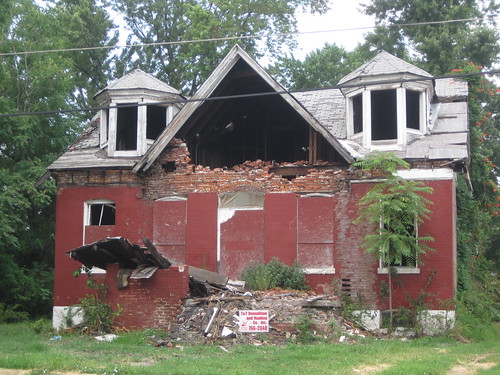
This unusual cross-gabled house with striking dormers, located at 3839 Lee Avenue in the Fairground neighborhood, is about to be demolished. Once it is gone, an irreplaceable building — seriously, what else looks like this in the entire city? — will be lost and a predictable death pattern will conclude. Fairground and the Third Ward will lose yet another building that could house people, maintain surrounding property values and generate city revenues.
This particular house was first noted as vacant by the Building Division in 1989. The house returned to that status in 1998, and never was occupied again. The downward spiral is evident in the collapsed gable end and mess of bricks below, but also in the ownership. In 2001, after owner Albert Martin defaulted on real property taxes, the house was auctioned by the Sheriff. No one bid. The house reverted to the city’s Land Reutilization Authority (LRA), which did little except keep the plywood boards on. LRA’s lack of enterprise is somewhat understandable given the house’s condition at acceptance. On February 24, 2000, the Building Commissioner condemned the house for demolition. (Even a preservationist is baffled at how long it has taken to get this one down.)
The odd little house on Lee Avenue’s tale is not exceptional, although it should be. A negligent owner let the building fall into disrepair, stops paying taxes, lets it get condemned and then lets it lapse to city ownership. The city lacked the means to reverse long-term decay, and did no marketing of the house. By the time the wrecker put his sign in the front lawn, the story was written and only needed the detail of when demolition would start.
However, this easy and certain death could just as well have been an easy and certain rebirth. The Assessor’s Office shows that the assessed value of land and improvements at 3839 Lee Avenue were a mere $670 in 2000. Again, this is not exceptional. Many houses like this one across the city — but especially in north St. Louis — go to tax sale with low assessments and low tax liens. The economics of preservation of many of these buildings are pretty favorable to a buyer.
Where are the buyers? There are few smart people starting to use the tax auctions for preservation. For instance, artist Theaster Gates’ Rebuild Foundation has purchased at least one Hyde Park building at tax auction for rehabilitation projects. With a plentiful supply of great buildings, many of which could be eligible for historic tax credits, and few competing bidders, there seems to be a hidden buyers’ market in this city. Hidden for long, however, and we could lose quite a bit of St. Louis.
by Michael R. Allen
On land once part of a thoroughfare renamed for our native superstar Josephine Baker now rises a menagerie of sculptures. In 2007, the city closed this block and deeded the land to St. Louis University, which planted grass. The university had just demolished a historic livery stable building at the northwest corner of the intersection for yet another giant Grand Center surface parking lot used sporadically for special events. The demolition and the resulting gaping asphalt heat island dealt a blow to nascent renewal on Locust Street, but the area has recovered somewhat. The little strip of closed street has even begun to become something other than an unpleasant lawn.
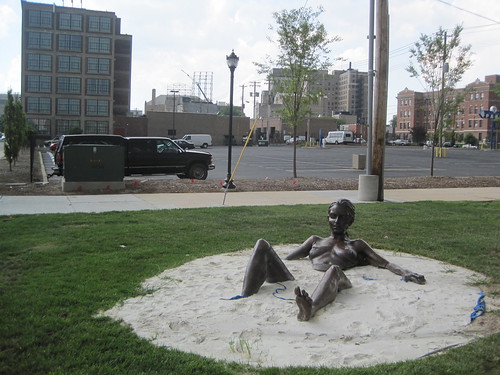
The lawn now sports this sultry nude, whose most private parts are tastefully concealed by earth and sand — yet the shapely parts that identify her as woman are evident to freshman and Fox patron alike. The careless reviewers who call this statue a mere figural representation of a naked young woman in a wading pool are incorrect. The intent of the artist no doubt is complex, and I surely am stumbling in my interpretation. Still, the lady clearly represents fair beauty Grand Center, with one foot playfully set upward suggesting the whimsy of the performing arts. The sand, however, represents the ominous force of parking lots. Our damsel is smiling yet actually is in distress.
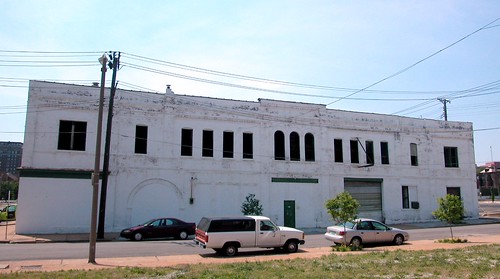
The paradox inscribed in a single statue is powerful, and far more useful to our citizens than any block of street or any nod to a long-gone banana-skirt-wearing dancer. Right?
by Michael R. Allen
The twists and turns of mid-century modern preservation in the last three weeks have been heartening. Let’s recap: since the end of June we have witnessed St. Louis University chipping away at Hellmuth Obata & Kassabaum’s IBM Building (1959) at 3800 Lindell, developers trying to green-light demolition of the old Schwarz & Van Hoefen-designed Phillips 66 gas station at 212 S. Grand (1967) and CVS quickly and almost quietly testing the waters of demolishing the W.A. Sarmiento-designed AAA Building (1977) at 3925 Lindell. The last two have generated a lot of public protest as well as the open concern of Mayor Francis Slay.

Many preservationists have expressed some version of “they can’t do this” or “how could they even think about it”. Fortunately mid-century modernism has reached a level of wide acceptability that, even if the three aforementioned buildings fall, will save dozens in the long term. Yet things have not always been this way for modern architecture here, and St. Louis retains the burden of having one of its most indelible recent-past architectural events being the destruction of innovative modern architecture.

Whoa — this writer just heard the mad dash of his readers! Of course, the phrase “Pruitt Igoe” is not one that enters into the mid-century modern dialogue alongside mentions of pleasant-named ranch house subdivisions and Jetson-modern round commercial buildings. Hyphenated public housing names are more likely to be denigrated in preservationists’ discussions of postwar urban renewal policy. The homes, offices, gas stations and diners of the middle and upper classes get the praise, the scholarship and the activist defense that modernist dwellings for the poor may never get.
Three South Side Buildings
by Michael R. Allen
A few weeks ago Thomas Crone’s excellent The South Side of Luck posted a video of me talking about three south side buildings. Crone’s instructions: find “one that was interesting and safe; one that was interesting and undergoing some type of facelift; and one that was interesting and in danger of going away.”
After some thought and elimination of dozens of possibilities — ranging from City Hospital to that little abandoned stone house at Steins and Water streets — I chose the Avalon Theater (in danger), the St. Louis Hills Office Center (“some type of facelift” indeed) and a minor Harris Armstrong commission at 3524 Gravois (interesting).
All I did was talk; Crone was producer, Brandon McLaughlin did the audio, and director Tyler DePerro filmed it all. Although we dodged gloomy weather that seems hard to believe on this 100-degree day, the shoot is a neat little document. Check it out. The get more tales — some also told through moving pictures — of the city’s south side over at The South Side of Luck.
by Hon. Terry Kennedy
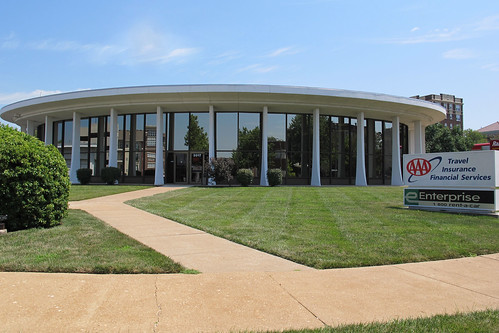
Alderman Terry Kennedy represents the 18th Ward that includes the AAA Building. Today he sent this statement.
I just want to correct some erroneous reporting recently made in the media. I do not support the demolition of the AAA building in the 18th ward located at Lindell near Vandeventer. Several news stories have reported this without ever speaking to me. I told CVS representatives, who are interested in establishing a store at this locations, that they must meet with our neighborhood association(s) close to this location, present their plans and receive their support before I can support the project. There are many aspects of the CVS proposal that I have concerns with but I am willing to be guided by the thoughts and ideas of the majority of our association members on this issue.
I have been willing to do those things that are consistent with already established planning for this portion of Lindell. This included the change of zoning of the Enterprise Leasing Office from “C” multi family to “H” commercial to be consistent with the other parcels owned by AAA and the other parcels on Lindell. This zoning change proposal was recommended by the City Planning Office and is also recommended in the Mayor’s Strategic Land Use Plan created over four years ago which I supported.
I welcome the interest CVS has in our area and think that there are benefits to having one of their stores in our community. However, before this can happen CVS must meet our residents vision for the area and address our concerns. Until then, I am open to discussing their ideas, giving advice and am willing to work with them where I can.
by Michael R. Allen
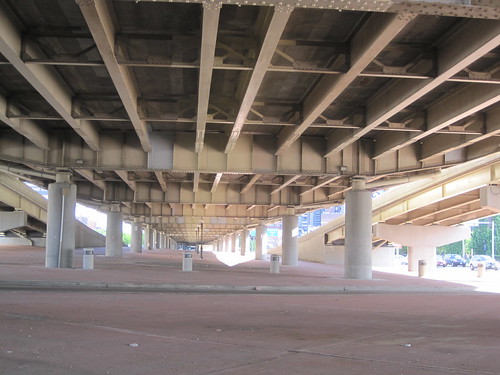
For the past tow years, the citizen group City to River has pushed for removal of I-70 through downtown St. Louis in order to better improve the connections between the city’s core and the riverfront around the Jefferson National Expansion Memorial. City to River’s practical and relatively affordable proposal is replacement of I-70 with an at-grade boulevard after the new Mississippi River Bridge opens in 2014. Then, I-70 will be carried away from the unsightly depressed and elevated lanes, which will get an inferior designation.
The boulevard plan won traction when the National Park Service’s General Management Plan for the Memorial included a very favorable mention of the boulevard idea. Then during the Framing a Modern Masterpiece competition, all five finalists ended up endorsing the proposal, with several explicitly drawing their own phased boulevard plans in their final competition proposals. Then the momentum came to a halt when the winner, Michael Van Valkenburgh Associates, got to work on creating a workable design. When that plan was unveiled on January 26 this year, the boulevard was nowhere to be found. City to River took a conciliatory tone, suggesting consensus that the boulevard was no longer a short-term goal for anyone.
Amid the reality that this city will be saddled with the ungainly mess of interstate that mars many a sight line downtown, yesterday City to River tweeted an idea that could make life with the highway a little less depressing.
Here’s the short story from Dezeen: A group in London called Assemle has built a cinema underneath a wharfside elevated highway (called a “flyover” in England). The project is called “Folly For Flyover” and lasts six weeks. The cinema’s entrance is made of reclaimed local brick supported by scaffolding in the shape of a historic row house. According to Dezeen: “Folly for a Flyover was assembled by a team of volunteers over the course of a month, using reclaimed and donated materials.”
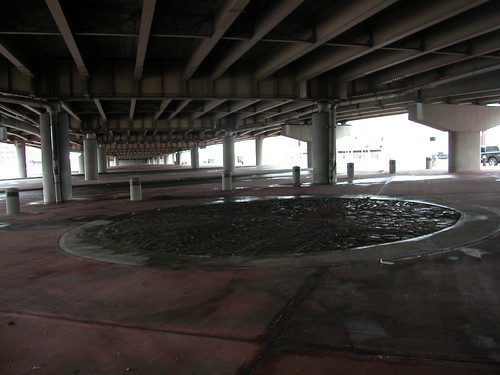
The architectural pun is clear and lovely: elevated highway construction took down many a historic building in previous decades, and demolition continues today (hence the available brick). Activating the otherwise-bleak space under the highway offers both a way to mitigate its dehumanizing form and the occasion to do a little teaching about the scale of materials and the impact of highways on cities.
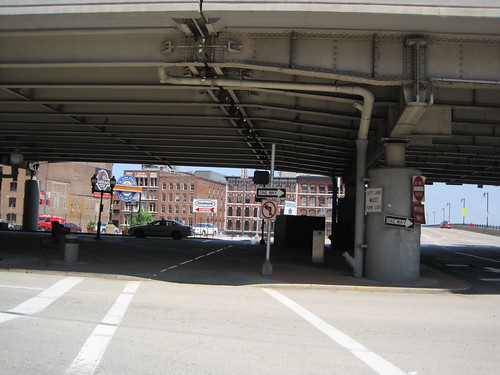
Can St. Louis try something similar? At present, even the three-block highway lid — which does nothing to offset the tragic landscape of the elevated lanes — included in Van Valkenburgh’s final plan will take years to build. Some temporary programming in our cavernous under-highway spaces downtown would make what could be a long wait for any changes to I-70 easier to bear.
The elevated structure itself is not the worst architecture in St. Louis, either. It is a utilitarian work of steel and concrete — there’s untapped visual potential that we should harness as long as it stands.
by Michael R. Allen
This week St. Louis University’s removal of the concrete block screens on the former IBM Building has visited the main elevation on Lindell Boulevard. Late in June, the university started removing the crucial architectural design feature on this early Hellmuth Obata & Kassabaum-designed office building, which dates to 1959 (see “SLU Picks Apart HOK”, July 1). Located at 3800 Lindell Boulevard and now called Adorjan Hall, the former IBM Building is part of a district of mid-century modern buildings built on Lindell Boulevard between 1945 and 1977.
The Lindell Boulevard modernism corridor includes Hellmuth Obata & Kassabaum’s earlier Sperry-Rand Building (1956) at Lindell and Sarah. That building has a similar modular plan to the IBM Building, with overhanging upper floors, clear-span window bays and very similar bay widths. Like the IBM Building, the Sperry-Rand Building gains its significance less from its own design than from its role in the larger Lindell Boulevard context. This plain, elegant International Style-inspired office block escaped the CVS demolition threat that has now taken aim at the W.A. Sarmiento-designed AAA Building at 3915 Lindell Boulevard (1976). Despite the drug store chain’s looking elsewhere, the fate of the Sperry-Rand Building is far from certain. Given the hatchet job being endured by the IBM Building, even preservation of the building could be a veiled threat.

